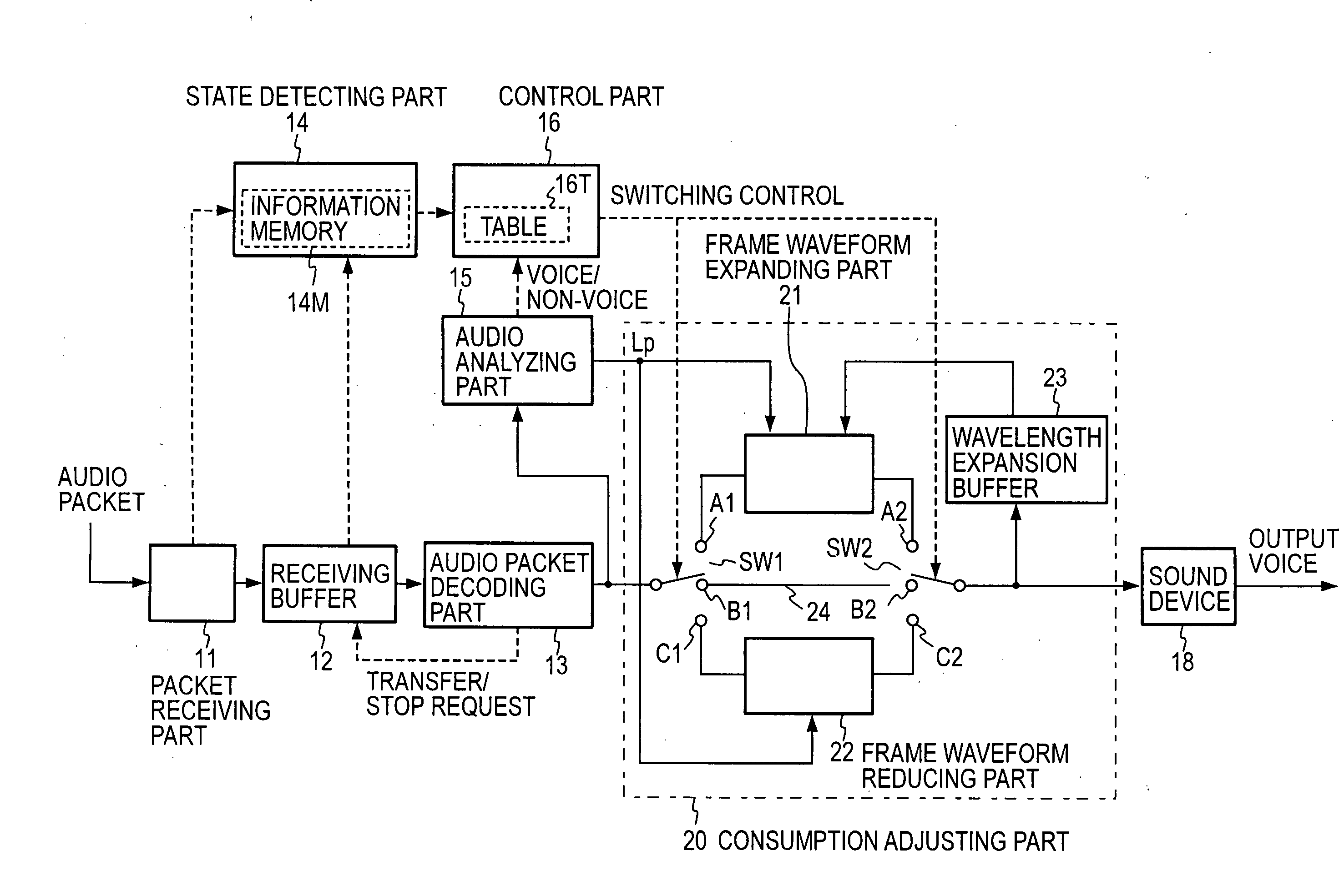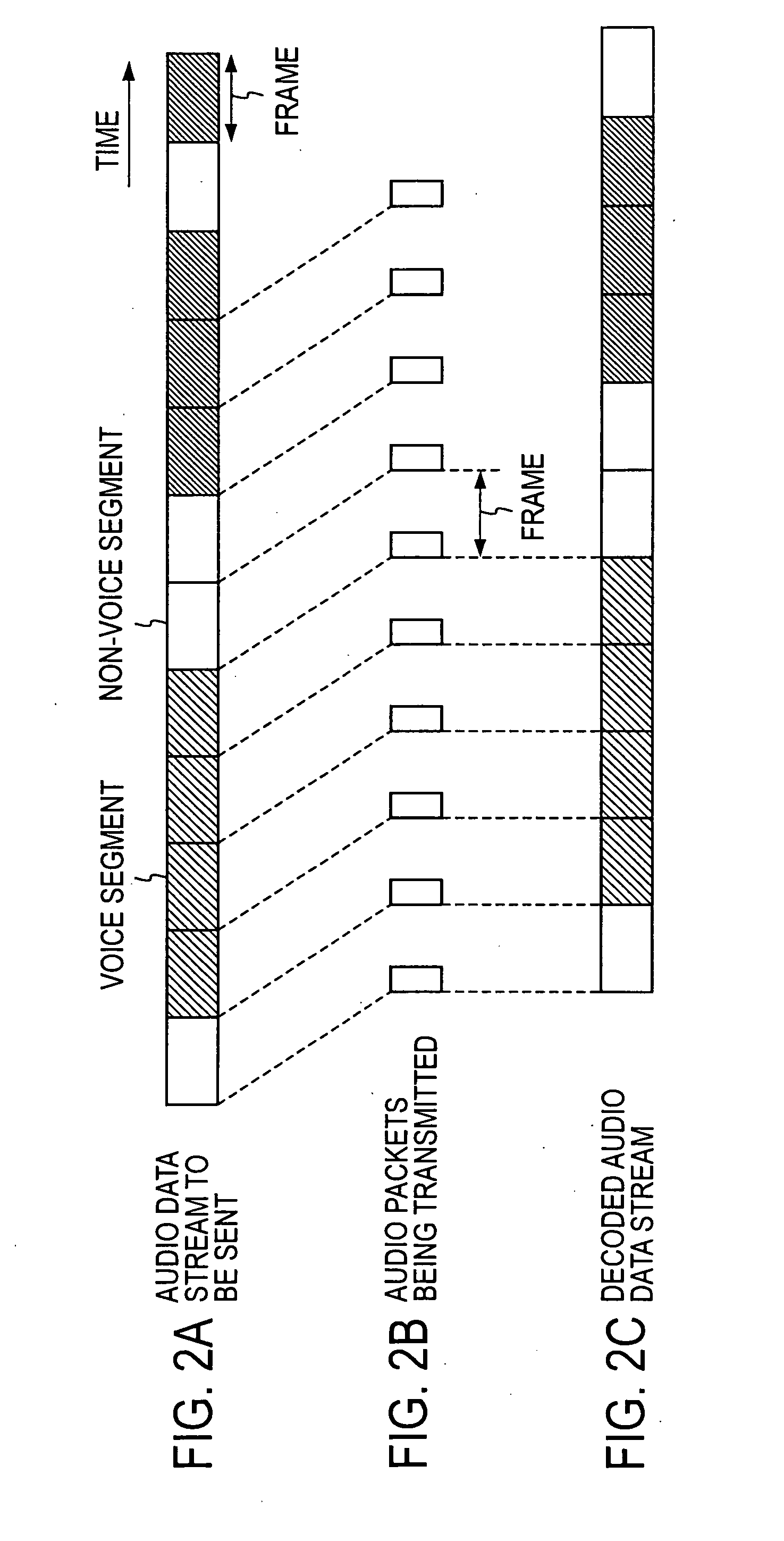Sound packet reproducing method, sound packet reproducing apparatus, sound packet reproducing program, and recording medium
a sound packet and reproducing technology, applied in multiplex communication, data switching networks, instruments, etc., can solve the problems of small delay in voice communication, awkward two-way voice communication quality, and inability to reproduce sound, so as to reduce voice communication delay, save costs, and save costs
- Summary
- Abstract
- Description
- Claims
- Application Information
AI Technical Summary
Benefits of technology
Problems solved by technology
Method used
Image
Examples
first embodiment
[0048]FIG. 3 shows an exemplary configuration of an audio signal receiving part according to the present invention, which includes a packet receiving part 11, a receiving buffer 12, an audio packet decoding part 13, a state detecting part 14, an audio analyzing part 15, a control part 16, a consumption adjusting part 20, and a sound device 18. The packet receiving part 11 receives audio packets from a communication network, stores them in the receiving buffer 12, and provides their arrival times and timestamps to the state detecting part 14. An audio packet contains an audio code generated by dividing an audio signal into time units having a given length (typically 10 to 20 milliseconds or so) called frames and converting the audio signal in the time unit by using an audio encoding technique, and a timestamp (corresponding to a frame number) indicating the order in time of the generation of the packet. A typical audio encoding technique is G.711 which is an ITU-T (International Tele...
second embodiment
[0127] In the audio analyzing part 15 shown in FIG. 6, the frame power Pf is compared against the fixed threshold Pth to determine whether a decoded audio signal in the current frame is in a voice segment or a non-voice segment. This configuration is advantageously simple. However, if a decoded audio signal contains high-level background noise (such as the hum of an air conditioner, babble in an office, or street noise), it may be difficult to precisely determine whether a frame is in a voice segment or a non-voice segment. FIG. 19 shows a configuration which alleviates the problem by taking into consideration background noise in voice segment / non-voice segment determination.
[0128] In the configuration of the audio analyzing part 15 shown in FIG. 19, a dynamic power threshold calculating part 150 is provided in addition to the components shown in FIG. 6, and a pitch correlation calculating part 158 performs pitch analysis to obtain the pitch length Lp and also obtain a pitch correl...
third embodiment
[0132] While determination is made whether each frame is in a voice segment or non-voice segment in the first and second embodiments, further determination is made in this embodiment as to whether a voice segment is a voiced sound segment or an unvoiced sound segment and whether a non-voice segment is a background noise segment or a silence segment. Thus, each frame is identified as any of the four types of segments, namely, voiced sound, unvoiced sound, background noise, and silence segments, and a consumption adjusting part 20 is controlled on the basis of the identification. A configuration of an audio analyzing part 15 used for this is shown in FIG. 20.
[0133] In the configuration of the audio analyzing part 15 shown in FIG. 20, a pitch correlation value r is provided also to a segment determining part 154 in the configuration shown in FIG. 19, both a dynamic power threshold Pd and a fixed power threshold Pth are used as the power thresholds in the segment determining part 154, ...
PUM
 Login to View More
Login to View More Abstract
Description
Claims
Application Information
 Login to View More
Login to View More - R&D
- Intellectual Property
- Life Sciences
- Materials
- Tech Scout
- Unparalleled Data Quality
- Higher Quality Content
- 60% Fewer Hallucinations
Browse by: Latest US Patents, China's latest patents, Technical Efficacy Thesaurus, Application Domain, Technology Topic, Popular Technical Reports.
© 2025 PatSnap. All rights reserved.Legal|Privacy policy|Modern Slavery Act Transparency Statement|Sitemap|About US| Contact US: help@patsnap.com



